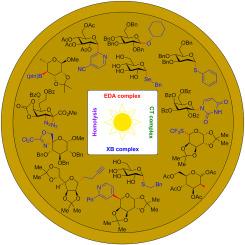Photocatalyst-free light-promoted carbohydrate synthesis and modification
IF 2.4
3区 化学
Q3 BIOCHEMISTRY & MOLECULAR BIOLOGY
引用次数: 0
Abstract
Photoredox catalysis has recently emerged as a powerful approach for preparing oligosaccharides because it uses mild conditions, is compatible with partially or completely unprotected carbohydrate substrates, and exhibits impressive regio‐ and stereo‐selectivity and high functional group tolerance. However, most catalytic photoredox reactions require an external photocatalyst (organic dye or expensive transition-metal complex) to deliver key glycosyl radicals. Several photocatalyst-free photocatalytic reactions that avoid the use of expensive metal salts or organic-dye additives have received significant attention. In this review, we highlight the most recent developments in photocatalyst-free light-promoted carbohydrate synthesis and modification, which is expected to inspire broad interest in further innovations in the green synthesis of saccharides.

无光催化剂光促进碳水化合物合成和改性。
光氧化催化最近已成为制备低聚糖的一种强有力的方法,因为它使用的条件温和,与部分或完全未受保护的碳水化合物底物兼容,并具有令人印象深刻的区域和立体选择性以及高官能团耐受性。然而,大多数催化光氧化反应都需要外部光催化剂(有机染料或昂贵的过渡金属复合物)来提供关键的糖基自由基。一些避免使用昂贵金属盐或有机染料添加剂的无光催化剂光催化反应受到了广泛关注。在这篇综述中,我们重点介绍了无光催化剂光促进碳水化合物合成和改性的最新进展,预计这将激发人们对糖类绿色合成进一步创新的广泛兴趣。
本文章由计算机程序翻译,如有差异,请以英文原文为准。
求助全文
约1分钟内获得全文
求助全文
来源期刊

Carbohydrate Research
化学-生化与分子生物学
CiteScore
5.00
自引率
3.20%
发文量
183
审稿时长
3.6 weeks
期刊介绍:
Carbohydrate Research publishes reports of original research in the following areas of carbohydrate science: action of enzymes, analytical chemistry, biochemistry (biosynthesis, degradation, structural and functional biochemistry, conformation, molecular recognition, enzyme mechanisms, carbohydrate-processing enzymes, including glycosidases and glycosyltransferases), chemical synthesis, isolation of natural products, physicochemical studies, reactions and their mechanisms, the study of structures and stereochemistry, and technological aspects.
Papers on polysaccharides should have a "molecular" component; that is a paper on new or modified polysaccharides should include structural information and characterization in addition to the usual studies of rheological properties and the like. A paper on a new, naturally occurring polysaccharide should include structural information, defining monosaccharide components and linkage sequence.
Papers devoted wholly or partly to X-ray crystallographic studies, or to computational aspects (molecular mechanics or molecular orbital calculations, simulations via molecular dynamics), will be considered if they meet certain criteria. For computational papers the requirements are that the methods used be specified in sufficient detail to permit replication of the results, and that the conclusions be shown to have relevance to experimental observations - the authors'' own data or data from the literature. Specific directions for the presentation of X-ray data are given below under Results and "discussion".
 求助内容:
求助内容: 应助结果提醒方式:
应助结果提醒方式:


